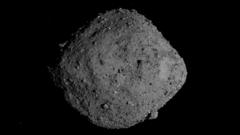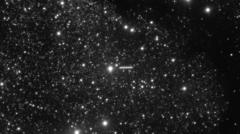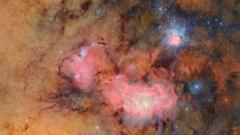The findings from NASA's Osiris Rex mission provide insights into how asteroids may have contributed to life on Earth and beyond.
**Asteroid Bennu Reveals Life's Building Blocks, New Research Shows**

**Asteroid Bennu Reveals Life's Building Blocks, New Research Shows**
Scientists uncover amino acids and key organic compounds in asteroid samples that support theories of life's cosmic origins.
The chemical building blocks of life have been discovered within the dust samples of asteroid Bennu, according to recent research. Analyzing material returned to Earth by NASA's Osiris Rex spacecraft revealed an impressive variety of minerals as well as thousands of organic compounds. Among these were amino acids—essential components of proteins—and nucleobases, the basic units of DNA.
Although this does not imply that life ever thrived on Bennu, the results bolster the hypothesis that asteroids were instrumental in delivering essential ingredients for life to Earth billions of years ago. Scientists speculate that similar compounds could also exist on other celestial bodies within our Solar System.
"What we've found is astonishing," said Professor Sara Russell, a cosmic mineralogist from the Natural History Museum in London. "It sheds light on our own beginnings and helps address profound questions about the origins of life. It’s a curiosity that speaks to everyone."
These findings appear in two papers published in the journal Nature. The mission to capture samples from Bennu has been described as one of NASA's most ambitious endeavors. The Osiris Rex spacecraft extended its robotic arm to gather material from the 500-meter-wide asteroid, which was then encapsulated and returned to Earth in 2023.
Around 120 grams of dark dust was collected and subsequently distributed to scientists worldwide. Though it may seem like a small amount, it has turned out to be a resource rich in information. "Each granule reveals something new about Bennu," says Prof. Russell, who received approximately a teaspoonful of the asteroid's material for research.
Analyses using scanning electron microscopes uncovered a multitude of nitrogen and carbon-rich compounds within the Bennu samples. Specifically, researchers found 14 of the 20 amino acids that are foundational to life on Earth and all four molecular building blocks of DNA: adenine, guanine, cytosine, and thymine. The study also discovered various minerals and salts, indicating the historical presence of water on the asteroid, as well as ammonia, which plays a crucial role in biochemical processes.
While some of these compounds have been recorded in meteorites that have previously landed on Earth, several were undetected until now. "The richness is astounding, with minerals previously unseen in meteorites and unique combinations. It's been a thrilling subject to study," Prof. Russell remarked.
This research enhances the existing evidence that asteroids, like Bennu, contributed both organic materials and water to a formative Earth. As explained by Dr. Ashley King from the Natural History Museum, the early Solar System was chaotic, with countless asteroids like Bennu colliding with the young Earth, potentially seeding it with the essential components for oceans and life.
While Earth is the only known planet to harbor life, the influx of asteroids likely occurred across the Solar System's other planets as well. "One crucial question we’re keen to explore is why life exists here on Earth and if it could emerge elsewhere in our Solar System under the appropriate conditions," Dr. King remarked.
With decades of research anticipated on Bennu's retrieved dust, scientists have much still to discover in our cosmic vicinity.
Although this does not imply that life ever thrived on Bennu, the results bolster the hypothesis that asteroids were instrumental in delivering essential ingredients for life to Earth billions of years ago. Scientists speculate that similar compounds could also exist on other celestial bodies within our Solar System.
"What we've found is astonishing," said Professor Sara Russell, a cosmic mineralogist from the Natural History Museum in London. "It sheds light on our own beginnings and helps address profound questions about the origins of life. It’s a curiosity that speaks to everyone."
These findings appear in two papers published in the journal Nature. The mission to capture samples from Bennu has been described as one of NASA's most ambitious endeavors. The Osiris Rex spacecraft extended its robotic arm to gather material from the 500-meter-wide asteroid, which was then encapsulated and returned to Earth in 2023.
Around 120 grams of dark dust was collected and subsequently distributed to scientists worldwide. Though it may seem like a small amount, it has turned out to be a resource rich in information. "Each granule reveals something new about Bennu," says Prof. Russell, who received approximately a teaspoonful of the asteroid's material for research.
Analyses using scanning electron microscopes uncovered a multitude of nitrogen and carbon-rich compounds within the Bennu samples. Specifically, researchers found 14 of the 20 amino acids that are foundational to life on Earth and all four molecular building blocks of DNA: adenine, guanine, cytosine, and thymine. The study also discovered various minerals and salts, indicating the historical presence of water on the asteroid, as well as ammonia, which plays a crucial role in biochemical processes.
While some of these compounds have been recorded in meteorites that have previously landed on Earth, several were undetected until now. "The richness is astounding, with minerals previously unseen in meteorites and unique combinations. It's been a thrilling subject to study," Prof. Russell remarked.
This research enhances the existing evidence that asteroids, like Bennu, contributed both organic materials and water to a formative Earth. As explained by Dr. Ashley King from the Natural History Museum, the early Solar System was chaotic, with countless asteroids like Bennu colliding with the young Earth, potentially seeding it with the essential components for oceans and life.
While Earth is the only known planet to harbor life, the influx of asteroids likely occurred across the Solar System's other planets as well. "One crucial question we’re keen to explore is why life exists here on Earth and if it could emerge elsewhere in our Solar System under the appropriate conditions," Dr. King remarked.
With decades of research anticipated on Bennu's retrieved dust, scientists have much still to discover in our cosmic vicinity.
















